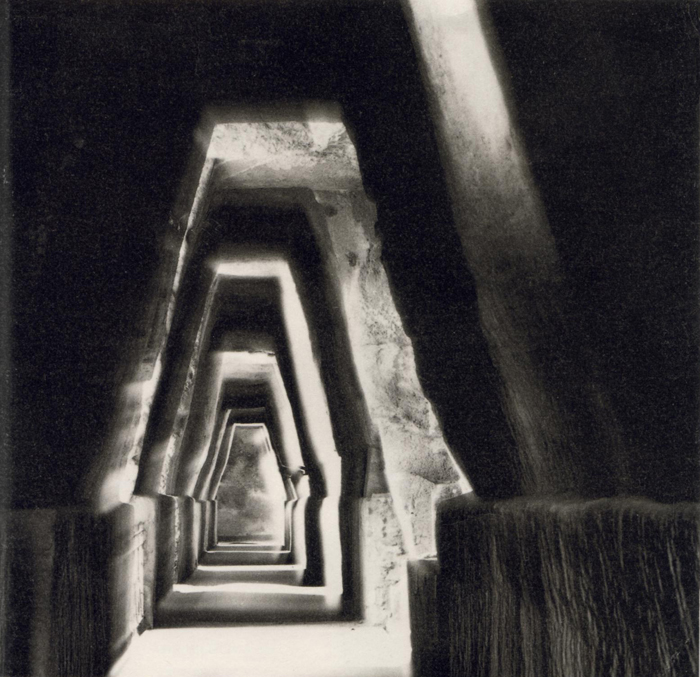
Mimmo Jodice, Entrance to the caves of the Cumaean Sibyl, Cumae, Italy, 1987.
Greek colonists on the west coast of Italy built the Cave of the Sibyl around 2500 years ago. It’s a work of architecture that only has an inside: a passageway built along the inner face of a hillside, with openings at intervals. Its only constituent parts are light, darkness, perspective and a keystone cross-section: the architecture itself is photographic. The passageway dead-ends in the room where the Sibyl told fortunes. She told Aeneas, who washed up in Cumae after fleeing Troy, that he was on the right track, that his descendents were going to be part of something big. Romulus and Remus came into the picture seven generations later. The Sibyl appears in paintings and literature during the Renaissance, and she’s on the ceiling of the Sistine Chapel. The Cave of the Sibyl was important to the Romans for explaining their connection to the Greeks. It goes without saying that this place, in real life, is just a footnote to its story and even its image. This photograph has been above my desk for the last 17 years. When I was last there, I wanted to take this picture, but I would have needed a permesso. I had to leave my tripod on the bus.
Kati Rubinyi, Artist, Educator, Researcher
Jeff Mermelstein, Photograph of sculpture by J. Seward Johnson, 2001.
Just five years after the World Trade Center rained down on lower Manhattan, this image by Jeff Mermelstein, which appeared in the New York Times Magazine on Sept 23, 2001, often reappears in my memory. I am astonished by it in the way that Edmund Burke explains this principle in relation to the sublime: “The passion caused by the great and sublime in nature… is astonishment; and astonishment is that state of the soul, in which all its motions are suspended, with some degree of horror.” I’m less interested in the formal qualities of the image as a photograph than in the power of the image as a document of a specific day, of a specific sequence of events, and everything that this document calls up even now: the indistinguishable detritus of lives past and present, alive and dead, strewn throughout a park emptied of people. Central to the monochromatic ashen scene, and to the emotion that the image calls up for me, is the statue seated on a park bench, himself covered in debris and hunched over what appears to be an open suitcase. He is unmoved, unflinching, suspended in time just as everything else has collapsed around him. The photographic record of this statue in the midst of chaos is an anomalous symbol both of hope and despair, of permanence and inescapable change.
Susan Silton, Visual Artist
